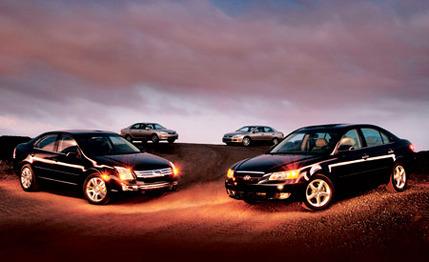
 Comparison Tests
Comparison Tests
No point in overcomplicating this matchup. The mid-size-sedan market has two promising new four-doors. So we've set up the newbies against the benchmarks of the class, the bestseller Toyota Camry and a perennial 10Best favorite, the Honda Accord. If a star or two have been born, this method should point them out pronto and tell us how bright they are.
What's new? America's own Ford has just given birth to the Fusion, a boldly sculpted four-door dropped into the yawning gap between the size-S Focus and the size-XXL Five Hundred. And Korea's Hyundai has replaced its seductively priced Sonata with an all-new wider, taller, longer Sonata that's lost none of its window-sticker allure.
A word of advice: Expect your expectations to be shattered in this exploration, starting with birthplaces. The new Korean is made in the U.S., and the new American model is not. Hyundai built an all-new manufacturing plant in Montgomery, Alabama, for this 2006 Sonata. Ford's Fusion is assembled in Hermosillo, Mexico, on a platform borrowed from its partner's Mazda 6.
Although the benchmarks need no introduction, a few facts may bring them into better focus. The Toyota Camry was new for the 2002 model year and has proven to be immensely popular in the market: 426,990 were sold in the U.S. last year. This is one of the most trusted cars in America.
Honda's Accord sells less well—386,770 found new American homes last year—but it's a consistent C/D favorite, having earned a 10Best award in 19 of the 23 years we've been publishing that list. The Accord in stores now, face-lifted for 2006, is the seventh generation to wear that name. It was a new design for the 2003 model year. Both the Accord and the Camry are built in U.S. plants—the Honda in Marysville, Ohio, and the Toyota in Georgetown, Kentucky.
While the Taurus still lingers in the Ford lineup, something for the fleets that insist on low, low prices, the Fusion is the logical replacement for that tired old workhorse. In size, the Fusion is about seven inches shorter than today's Taurus, but it's longer than the mid-'80s original (see sidebar). Today's discerning buyers, however, don't look to the Taurus as a reference. The Camry and the Accord set the tone of the market, and Ford has obviously used them as benchmarks just as we have. The Fusion is an inch longer than the Camry and nearly an inch shorter than the Accord, on a wheelbase that splits the fraction between them.
Really, there are no significant differences in exterior dimensions among any of these models. These four sedans are meant to compete vigorously for your dollars, and their makers have been diligent in duplicating the virtues of their opponents.
Although all these mid-sizers come with four-cylinder engines, manual gearboxes, and cloth interiors as standard equipment, we've moved our selections up the options lists to include V-6 engines, automatics, leather interiors, and other sybaritic pleasantries—seat heaters and steering-wheel radio controls, for example. The as-tested prices range from $23,495 for the Hyundai on the low end to $29,850 for the Accord, a price pumped up by a navigation system that gave this Honda no advantage in our ratings.
As usual, our driving included a mix of local roads and freeways, plenty of door slamming as passengers of varying sizes slid into and out of the seats, plus a full schedule at the test track. The benchmark models, of course, have made these same runs many times before. Which raises the question: Will one or both of them be edged out of their reference roles by the new guys? Let's find out.